Forward Facing Sonar (FFS) is one of the most exciting and important technologies to reach the recreational fishing world in the last decade.
By now, you’ve heard the buzz surrounding this new category of fishing electronics. But what is it, and is it worth the intense hype surrounding it?
In this article, you will learn in simple terms what forward facing sonar is, how it works, the cost, and how it can help you with fishing.
What is Forward Facing Sonar
Forward Facing Sonar are transducer systems that can show sonar returns from whatever direction an angler is fishing. Some call the whole category “Livescope,” having been released first, but each major fish finder brand has developed a version of the technology.
Most people will tell you Forward Facing Sonar is only “live” sonar imaging, like Livescope, Active Target, and MEGA Live – and that will be the focus of this article.
However, 360 Imaging should also be considered FFS! 360 imaging shows a continuously updated picture of what is in front of and around the boat; it’s just not a “live” image.
Up until FFS, fish finders were showing us “history.” Whatever you saw on the screen was either directly below or already behind the boat. The transducer pinged, received a return, and the fish finder painted that to the screen.
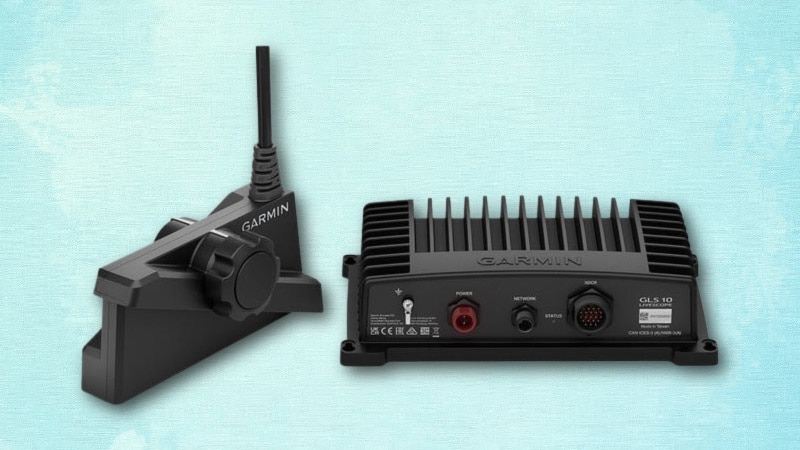
With FFS, anglers can now have real-time forward-looking sonar on their fish finders while the boat sits entirely still.
Anglers with Forward Facing Sonar have the massive advantage of seeing structure and fish on their screens before ever needing to make a cast.
How Forward Facing Sonar Works
Think about forward-looking sonar systems as large ultrasounds designed for use in water. They both create an image that appears “live,” capturing movements in the target area. There are key differences, of course.
Expensive medical ultrasound transducers are designed to image small areas of the body at close range (a few feet), operating at high frequencies ranging from 2.5 to 15 MHz.
Forward Facing Sonar transducers must cover broad sections of the water column at much longer ranges (up to 120 feet) and operate at medium frequencies in the 0.5 to 1.2 MHz range.
So how does this all work on the water? Forward Facing Sonar system has three components:
- Transducer – Sends and Receives the sonar signals.
- Black Box – Crunches the sonar signals with complicated math and algorithms and sends the data to the display.
- Fish Finder – The images are displayed on the screen and can be adjusted with the typical Contrast and Sensitivity settings.
Most anglers are familiar with sonar “black boxes” and fish finders, so let’s focus on the transducer. Lowrance had one for years to run their Side Scan and Down Scan sonars.
I am still waiting to see someone cut open a Livescope transducer, so we have to look at the available information on ultrasound transducers.
On a Livescope transducer, we can observe three long rectangular sections containing the piezo elements. Google searching for ultrasound transducer images, we find these pictures that look similar.
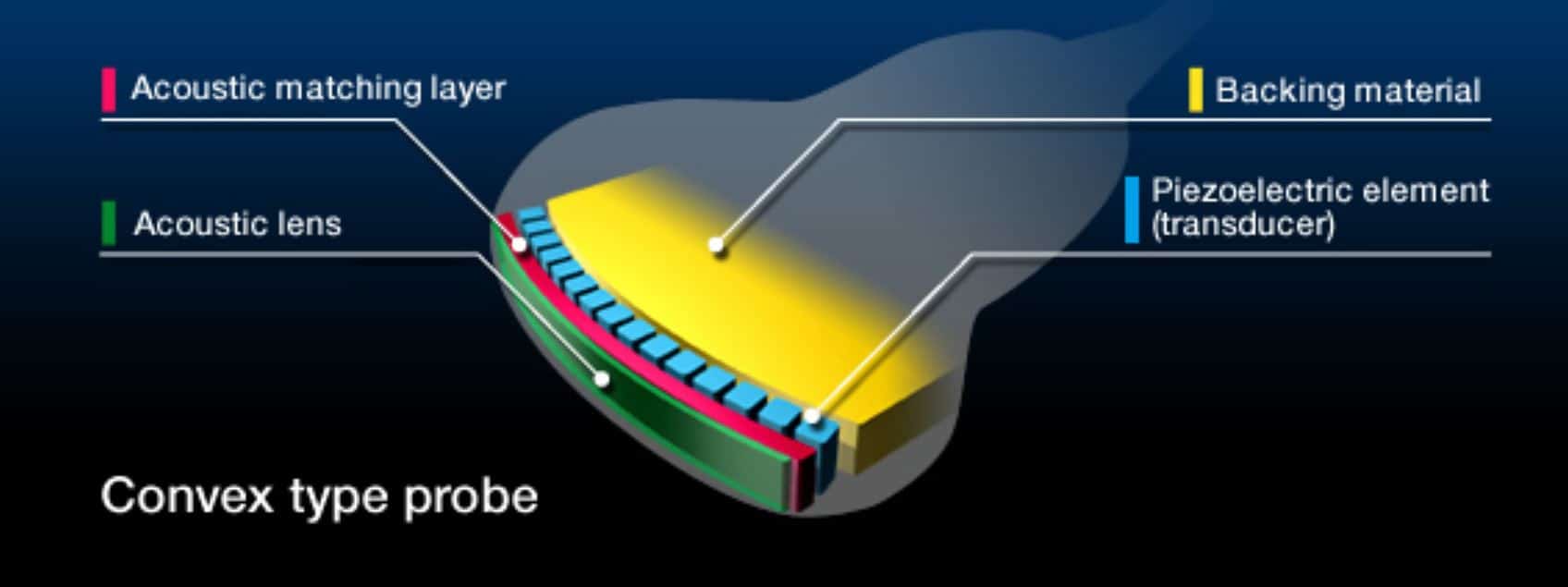

We can infer that each section of the Livescope transducer also has many piezo elements. Each small piezo crystal sends and receives many sound pulses from a tiny part of the water column. Each section of elements then makes up one-third of the total image.
Think of FFS as hundreds of tiny transducers working together as one larger transducer.
Combine them all (using electronics and math magic in the black box), and you get an image on the fish finder of the water in front of the transducer that appears to be live, much like the squirming baby in its mother’s belly at the ultrasound appointment.
What Forward Facing Sonar Can Do
Forward facing sonar gives anglers a live view of the water column in whichever direction the transducer is pointed and oriented.
The FFS transducer can be oriented in 3 ways – Forward, Down, and Top Down.
What kinds of things can these sonar views tell us?
- Type, size, and shape of cover and structure
- Presence of fish
- Quantity, Size, and Position of the fish
- Presence of bait
Forward Mode – In this most commonly used mode, the transducer shows us a vertical pie slice of the water column stretching from the surface to the bottom.
Anglers that can cast their lure in the transducer’s cone (a skill in itself) can track the lure back to the boat, watching how the fish react.
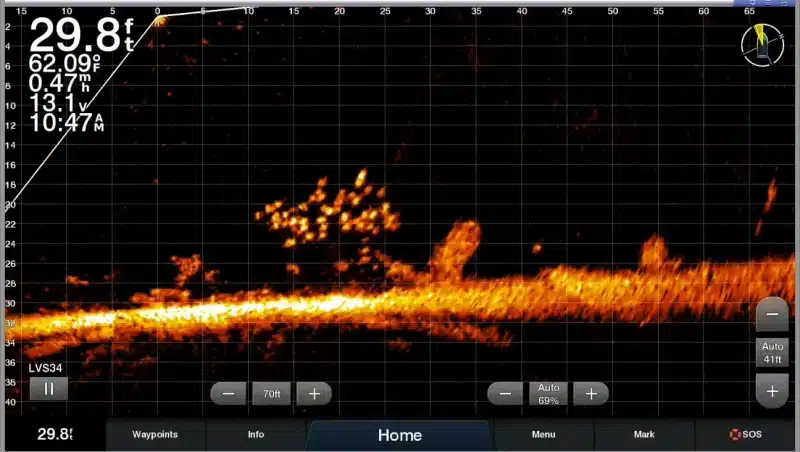
Down Mode – The transducer has the center section pointed straight down. This mode is best for vertical fishing with spoons, jigs, drop shots, and ice fishing.
Anglers can target and fish for individual fish, dropping their lure directly above them. This technique is deadly for walleye, smallmouth bass, and deep-water fishing.
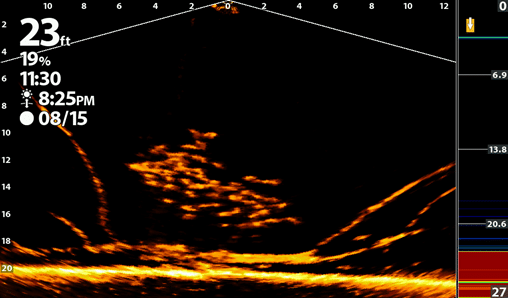
Horizontal Mode – On Livescope, this is called Perspective Mode and is named Landscape Mode on MEGA Live. This orientation images a horizontal slice of the water column useful in shallow water and trolling.
Fishing for bedding panfish has never been easier than watching them as they guard their beds.
With that information at your fingertips – at all times – in any direction you choose, you can see how powerful this technology is for fishing.
What more could you possibly want to know without ever having to make a cast?
Is Forward Facing Sonar Ethical?
The ease of locating and catching fish has made many anglers question how fair fishing is with forward facing sonar like Livescope.
Some anglers view it simply as a new tool for locating and catching their fish.
Some anglers believe it takes the sport out of fishing and that the technology will ultimately harm the health of our fisheries.
It’s best to spend some time fishing with FFS to understand what it can and can’t do before forming your opinion.
Does Livescope Ruin the Fun of Fishing?
I can’t say I’ve seen the fun aspect talked about much concerning live sonar.
Remember when you were younger and didn’t have all these expensive electronics? Half the fun of fishing was wondering when and where your next will happen. Using your eyes and ears to imagine where the best areas to fish could be.
Forward looking sonar diminishes the mystery of fishing as we experienced it as kids. But – fishing with live sonar is undoubtedly fun, but in a far different way than we are used to.
Should Livescope Be Banned?
The most extreme voices on social media will yell at clouds and say – Livescope should be banned!
On the other end, they say only after all our lakes get fished out will FFS be outlawed.
Certain fishing leagues, both pro and amateur might someday offer different classes of competition – One with Forward Sonar and one without.
The Professional Muskie Team Tour has already taken that step, becoming the first tournament series to ban its use in competition.
Bottom line – the tech isn’t going away, and will only get better with time, so we all have to get used to it.
Your Next Steps
If you want to learn more about FFS and the different systems you can buy today, here are more related topics to continue your journey:
- What is the Best Forward Facing Sonar?
- Best Livescope Combos
- Best Battery for Forward Facing Sonar
- Garmin Livescope vs. Lowrance Active Target
- Garmin Livescope vs. Humminbird MEGA Live
- MEGA 360 vs. Livescope


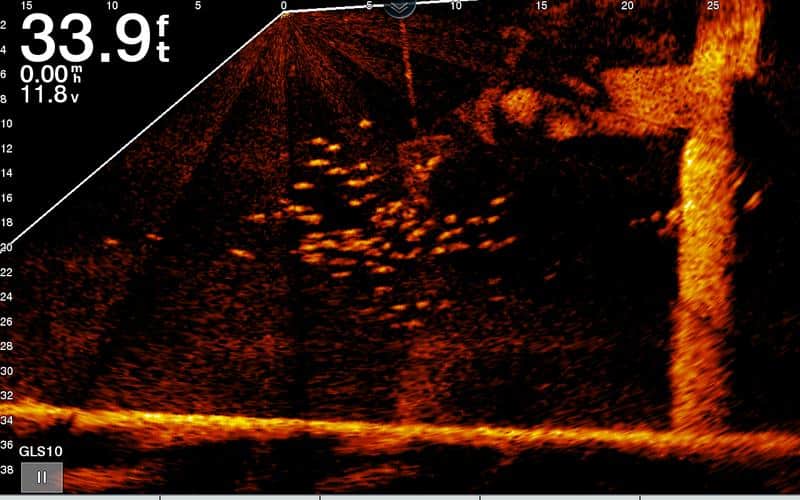

The FFS technology is really just another tool to assist the angler in locating fish. The article states that back in the day that half the fun was trying to locate a good fishing spot. Well I was a kid back in the day and locating a good spot was not really any fun, because if you were fishing an unfamiliar body of water, you most likely would locate that good spot only 10% of the time. Today there are a lot fewer young people fishing then there were back in the day. one reason for that is a child today has very little patience for most things, especially when it comes to fishing. So maybe this technology can change that somewhat. You still need to have an idea of where the fish will be before you ever cast out a line. Even knowing where the fish are doesn’t guarantee you’ll catch fish. You still need to have the right baits, the right presentation to have a chance at catching a fish. As far as fish population goes, the fishery management will simply have to place better harvesting regulations and more regulations on the type of baits and tackle that can be used to catch fish. Elemenating live a cut baits would greatly help with fish survival. Tournament fishing will have to decide on their own what they will and will not allow. There’s nothing more frustrating for a young child to be so excited about going fishing, especially for the first time and not catching anything. The chances of getting that youngster back out to fish again is not going to be easy.